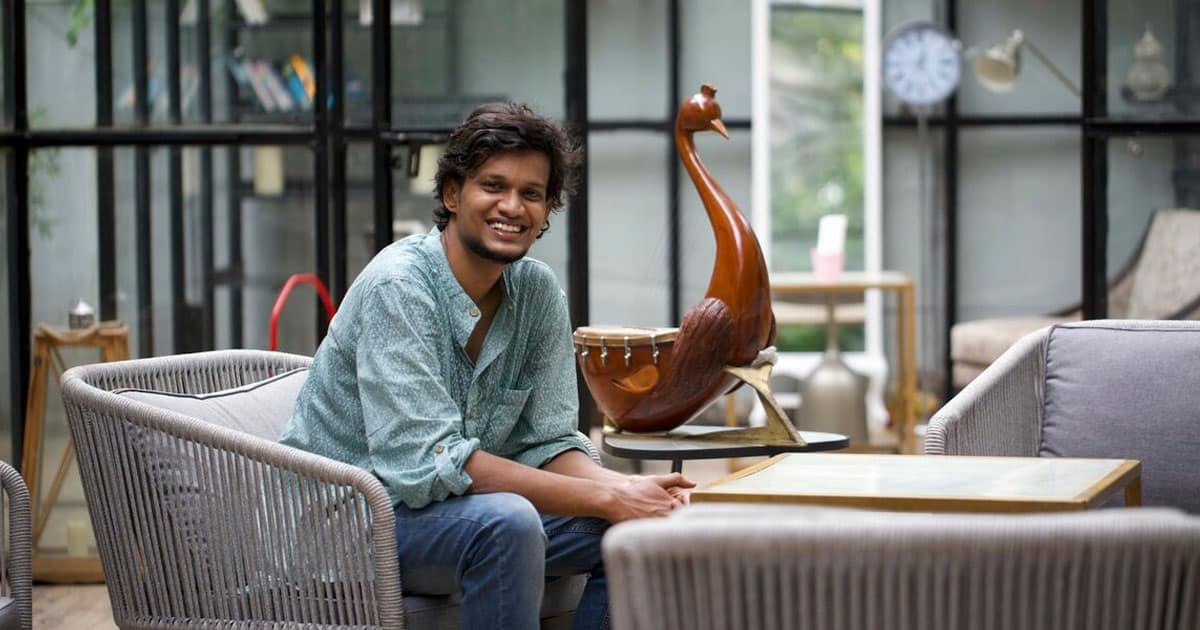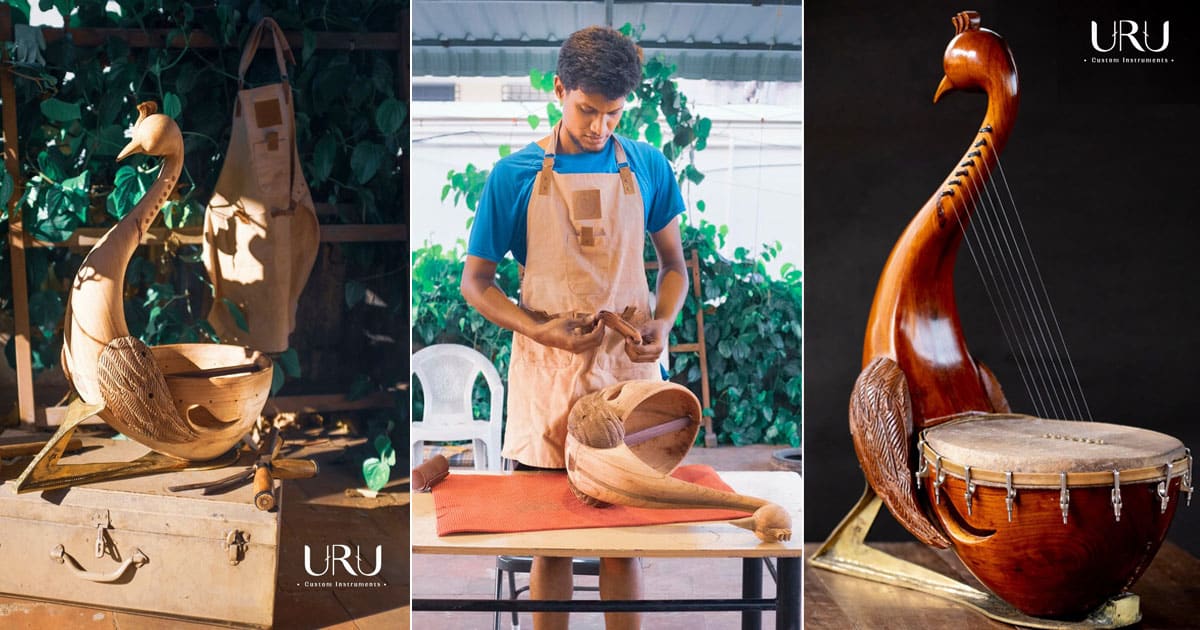Indian Classical Music is debated as the most ancient form in the entire world. Though music initially manifested through vocals, with observance of sounds of nature and certain animals, humans understood rhythm that could be created from inanimate objects. With this, they developed numerous instruments that accompany vocals or are played.
Broadly, musical instruments in India are classified on the basis of morphological characteristics which go as: stretched (strings), covered (drums), hollow (wind), and solid (bells).
Yet with globalization and the growing popularity of Western music, several Indian instruments have become obscure over time.
This very fact is what struck Tharun Sekar, an architect turned musician and instrument maker from Chennai. He, like almost all people in music in today’s date, was initially exposed to the Western and popular Indian instruments. That is when he realized the need for reviving the instruments that have been lost in time and set forth to recreate them with his own hands.
LifeBeyondNumbers got in touch with Tharun to learn more about his work.

It was a Hawaiian lap steel guitar that led Tharun to try his hands in making instruments in his teens. Soon he happened to love the process. But on the contrary, he pursued architecture. This did not end his knack but rather fate took him to Auroville where he delved into the art of instrument making further and made it his profession.
“I was in 10th grade when I saw the Hawaiian lap steel guitar and wanted to play it. However, at that time, this guitar wasn’t available in India. So, I watched YouTube videos and tried making the guitar. The process of working with wood became addictive; I was fascinated by it. I thought about its texture, how it felt in my hands. Finally, when I made the instrument and heard its sound, it felt wonderful. Later, I decided to pursue architecture in college, because I wanted to study design. During my summer vacations, I built a string instrument each year, including a banjo and a ukulele. Then I went for an architectural internship in Auroville. It was there that I met a well-known luthier, Erisa Neogy, to whom I showed my instruments. He was kind and was willing to teach me more about instrument-making, which led me to train under him for six months. Since the process fascinated me, after graduating from college, I decided to devote all my time to making instruments,” shared Tharun.
While learning to make instruments from Erisa, it dawned upon Sekar that the young generation in India is very much attracted to Guitar or any other Western instrument. No one would even try to think of an Indian instrument as a first choice. As he was getting to know about the technicalities, he noted that Guitar remains prevalent because luthiers have been modifying it as per the changing taste of generations. He wanted the same to happen to Indian Instruments. And that is why he launched Uru – his company that is dedicated to the revival of Indian instruments.
“During my time in Auroville, I wondered why I was only making Western instruments. I realized that Western instruments, like the guitar, were everywhere. If students wanted to learn music, the first thought they’d have was to pick up a guitar or play the drums. They wouldn’t even think of playing an Indian instrument. This was something that bothered me. The guitar, which only has a history of 500 years, continues to remain popular due to gradual design changes made to it every decade. Hundreds of luthiers work on the instrument, trying out something new to keep the form modern for younger generations. I thought I should do the same with Indian instruments. This is why I started Uru, a company where we redesign folk instruments,” Tharun said.
Tharun’s first project in his workshop is Yazh – a distant cousin of the harp, the 2,000-year-old instrument was once a mainstay in royal courts, and produced “the sweetest sound.” No one in India knows or makes the instrument at the moment apart from Tharun. So, he had to do a lot of research and hard work to create it.
The 24-year-old took five to six months to build the instrument which is made from a solid block of wood. A finished Yazh is about two feet tall, with seven or 14 strings, a distinctively carved peacock head, slender neck, and a bowl-like resonator. Tharun had to do a great deal of research to find the whereabouts of the instrument before trying his hands on recreating it.
“The beauty about this instrument is that it was once played in temples and in royal courts, as well as among panars, who were an ancient community of musicians. There are Tamil scriptures and literary works written during the Sangam period, sixth century B.C. to the third century that mention the yazh. Yet, it disappeared. Today, while there are replicas of the yazh available in museums, they are neither original nor playable. I wasn’t also able to find any recorded sound samples or videos of the instrument. So, this created a curiosity in me. After much research, I found the Yazh Nool, written by Swami Vipulananda in 1947, which is the only proper research book available on the instrument. The book has detailed information on music theory, how the strings were aligned and musical notations that helped to recreate the sound accurately,” narrates Tharun.
Making Yazh by the description in the book seemed a daunting task for Tharun. So, he modified the raw materials and mechanism of the instrument just about in a way to produce the exact sound imitating the ancient ones.
“Traditionally, the yazh makers used jackfruit wood. Goatskin would be tightly placed over the instrument’s bowl-shaped resonator. They would use crushed turmeric paste to glue the hide onto it. However, there was a problem with this. If you wanted to change the tone of the instrument by tightening the skin, you would have to open the entire piece and expose it to heat each time. So, I decided to introduce the hook-and-bracket system to compensate for this. I also used red cedar, which is lighter than jackfruit wood, to ensure ease in mobility. While carving the resonator, its thickness is determined by tapping the body of the wood and listening. At the point where it starts to ring well, I stop,” explained the musician.
Following Yazh, Tharun is on to remake and revive the panchamukha vadyam, or the five-faced drum, which belonged to the Chola dynasty period, from the ninth through 13th centuries. It is a percussion instrument that has five hollow tunnels with skin attached to it. The body is said to be made of bronze and weighed around 200 kilos (440 pounds). The only original piece that exists today is in a temple in Tiruvarur which will Tharun’s next stop so as to study it in detail.

Besides making Indian instruments, Tharun has an affinity towards almost all kinds of instruments around the world and has tried his hands in making them as well. He likes to visit the native places of the instruments and learn about them before creating them. Since the pandemic has restricted his movement, he is dedicating all his time to the indigenous instruments.
“I’m interested in making different instruments from around the world because I want to study different sounds. I recently made the cajón (a Peruvian percussion instrument), which took two months to build. I also want to craft the Mongolian morin khurr (also known as a horsehead fiddle) and have started researching it. However, part of my process includes hearing stories from local people, which gives me a better understanding of the instrument. Due to the pandemic, this is not currently possible. So, I thought that it might be better to focus on the instruments we have in my part of the world at the moment,” Tharun says.
Tharun’s work and instruments have been acclaimed across several countries. He creates each of these pieces on a pre-order basis at the moment. Visit Uru for more information.

